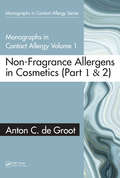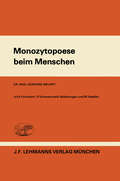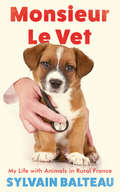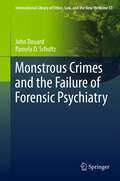- Table View
- List View
Monographs in Contact Allergy, Volume 1: Non-Fragrance Allergens in Cosmetics (Part 1 and Part 2) (Monographs in Contact Allergy #1)
by Anton C. de GrootMonographs in Contact Allergy, Volume 1: Non-Fragrance Allergens in Cosmetics (Part 1 and Part 2) is the first 2-part volume in an exciting series on contact allergy. It presents over 500 natural or synthetic chemicals and compounds which have caused allergic contact dermatitis in cosmetic products. Included here are INCI names, synonyms, description/definition, CAS and EU numbers, chemical class, function in cosmetics, molecular formula, structural formula and advice on patch tests. A full literature review is given of patch testing in patients, case reports of cosmetic allergic contact dermatitis, irritant contact dermatitis, photosensitivity, immediate contact reactions and systemic side effects. This text is suitable for anyone with an interest in contact allergy, from university students to professionals, and all readers will find this informative and detailed series an invaluable resource. Key Features: Monographs of all known non-fragrance chemicals and substances which have caused allergic contact dermatitis from their presence in cosmetic products Provides lists of all functional groups (such as antioxidants, preservatives, artificial nail building, emollients, hair dyeing, hair colorants) in both the EU and US formats and all chemicals in these groups which have caused cosmetic allergy Presents an alphabetical list of all synonyms indicating their INCI names Reported cross-reactions, pseudo-cross-reactions and co-reactions, patch test sensitization and presence in cosmetic products (including data from FDA’s Voluntary Cosmetic Registration Program) and chemical analyses are discussed Covers an extensive amount of information to benefit dermatologists, allergists, and non-medical professionals involved with the research, development and marketing of cosmetic products
Monographs in Contact Allergy, Volume 1: Non-Fragrance Allergens in Cosmetics (Part 1 and Part 2) (Monographs in Contact Allergy #1)
by Anton C. de GrootMonographs in Contact Allergy, Volume 1: Non-Fragrance Allergens in Cosmetics (Part 1 and Part 2) is the first 2-part volume in an exciting series on contact allergy. It presents over 500 natural or synthetic chemicals and compounds which have caused allergic contact dermatitis in cosmetic products. Included here are INCI names, synonyms, description/definition, CAS and EU numbers, chemical class, function in cosmetics, molecular formula, structural formula and advice on patch tests. A full literature review is given of patch testing in patients, case reports of cosmetic allergic contact dermatitis, irritant contact dermatitis, photosensitivity, immediate contact reactions and systemic side effects. This text is suitable for anyone with an interest in contact allergy, from university students to professionals, and all readers will find this informative and detailed series an invaluable resource. Key Features: Monographs of all known non-fragrance chemicals and substances which have caused allergic contact dermatitis from their presence in cosmetic products Provides lists of all functional groups (such as antioxidants, preservatives, artificial nail building, emollients, hair dyeing, hair colorants) in both the EU and US formats and all chemicals in these groups which have caused cosmetic allergy Presents an alphabetical list of all synonyms indicating their INCI names Reported cross-reactions, pseudo-cross-reactions and co-reactions, patch test sensitization and presence in cosmetic products (including data from FDA’s Voluntary Cosmetic Registration Program) and chemical analyses are discussed Covers an extensive amount of information to benefit dermatologists, allergists, and non-medical professionals involved with the research, development and marketing of cosmetic products
Monographs in Contact Allergy, Volume 3: Topical Drugs (Monographs in Contact Allergy #4)
by Anton C. de GrootThis third volume in an exciting and detailed series on contact allergens provides monographs of all 384 topical drugs which have caused contact allergy/allergic contact dermatitis. The monographs present: Identification section; Contact allergy (general population, patients with dermatitis, case reports and case series); Cross-reactions; Patch test sensitization; Photocontact allergy; and Immediate contact reactions (contact urticaria). Separate chapters present an overview of all aspects of allergic contact dermatitis to topical drugs, contact allergy to non-drug ingredients in topical pharmaceuticals and a preview of delayed-type allergy to systemic drugs (to be discussed in Volume 4). Key Features: Presents monographs of all known topical drugs which have caused contact allergy/allergic contact dermatitis Provides a full literature review of relevant topics of allergenic topical drugs Identifies IUPAC names, synonyms, CAS and EC numbers, structural and chemical formulas, Merck Index monographs, and advises on patch testing Presents non-drug allergens in topical pharmaceuticals Covers an extensive amount of information to benefit dermatologists, allergists, and all others interested in drug allergy
Monographs in Contact Allergy, Volume 3: Topical Drugs (Monographs in Contact Allergy #4)
by Anton C. de GrootThis third volume in an exciting and detailed series on contact allergens provides monographs of all 384 topical drugs which have caused contact allergy/allergic contact dermatitis. The monographs present: Identification section; Contact allergy (general population, patients with dermatitis, case reports and case series); Cross-reactions; Patch test sensitization; Photocontact allergy; and Immediate contact reactions (contact urticaria). Separate chapters present an overview of all aspects of allergic contact dermatitis to topical drugs, contact allergy to non-drug ingredients in topical pharmaceuticals and a preview of delayed-type allergy to systemic drugs (to be discussed in Volume 4). Key Features: Presents monographs of all known topical drugs which have caused contact allergy/allergic contact dermatitis Provides a full literature review of relevant topics of allergenic topical drugs Identifies IUPAC names, synonyms, CAS and EC numbers, structural and chemical formulas, Merck Index monographs, and advises on patch testing Presents non-drug allergens in topical pharmaceuticals Covers an extensive amount of information to benefit dermatologists, allergists, and all others interested in drug allergy
Monographs in Contact Allergy, Volume 4: Systemic Drugs (Monographs in Contact Allergy #4)
by Anton C. de GrootThis fourth volume in an exciting and detailed series on contact allergens and drug allergy provides monographs of all 507 systemic drugs which have caused delayed-type cutaneous drug hypersensitivity reactions and/or occupational allergic contact dermatitis. The monographs present: Identification section; Occupational allergic contact dermatitis; and Cutaneous adverse drug reactions from systemic drugs caused by type IV (delayed-type) hypersensitivity, as shown by positive patch tests (e.g. maculopapular eruption, acute generalized exanthematous pustulosis [AGEP], symmetrical drug-related intertriginous and flexural exanthema [SDRIFE], fixed drug eruption, drug reaction with eosinophilia and systemic symptoms [DRESS], and photosensitivity). Separate chapters present an overview of the spectrum of allergic cutaneous drug reactions, diagnostic tests, immediate contact reactions (contact urticaria), and systemic drugs that have acquired delayed-type hypersensitivity only by cross-reactivity. Key Features: Presents monographs of all known systemic drugs which have caused delayed allergic cutaneous drug reactions and/or occupational allergic contact dermatitis Provides an extensive literature review of relevant topics of allergenic systemic drugs, part of which is hard or impossible to find in database searches Identifies IUPAC names, synonyms, CAS and EC numbers, structural and chemical formulas, Merck Index monographs, and advises on patch testing Presents immediate contact reactions (contact urticaria) from systemics drugs and delayed-type hypersensitivity in drugs caused only by cross-reactivity Covers an extensive amount of information to benefit dermatologists, allergists, and all others interested in drug allergy
Monographs in Contact Allergy, Volume 4: Systemic Drugs (Monographs in Contact Allergy #4)
by Anton C. de GrootThis fourth volume in an exciting and detailed series on contact allergens and drug allergy provides monographs of all 507 systemic drugs which have caused delayed-type cutaneous drug hypersensitivity reactions and/or occupational allergic contact dermatitis. The monographs present: Identification section; Occupational allergic contact dermatitis; and Cutaneous adverse drug reactions from systemic drugs caused by type IV (delayed-type) hypersensitivity, as shown by positive patch tests (e.g. maculopapular eruption, acute generalized exanthematous pustulosis [AGEP], symmetrical drug-related intertriginous and flexural exanthema [SDRIFE], fixed drug eruption, drug reaction with eosinophilia and systemic symptoms [DRESS], and photosensitivity). Separate chapters present an overview of the spectrum of allergic cutaneous drug reactions, diagnostic tests, immediate contact reactions (contact urticaria), and systemic drugs that have acquired delayed-type hypersensitivity only by cross-reactivity. Key Features: Presents monographs of all known systemic drugs which have caused delayed allergic cutaneous drug reactions and/or occupational allergic contact dermatitis Provides an extensive literature review of relevant topics of allergenic systemic drugs, part of which is hard or impossible to find in database searches Identifies IUPAC names, synonyms, CAS and EC numbers, structural and chemical formulas, Merck Index monographs, and advises on patch testing Presents immediate contact reactions (contact urticaria) from systemics drugs and delayed-type hypersensitivity in drugs caused only by cross-reactivity Covers an extensive amount of information to benefit dermatologists, allergists, and all others interested in drug allergy
Monoklonale Antikörper: Anwendung in der Medizin
by Rüdiger V. Baehr Hubert P. Ferber Tomas PorstmannMonoklonale Antikörper: Herstellung und Charakterisierung
by Johann H. Peters Georges Köhler Horst BaumgartenMonoklonale Antikörper: Herstellung und Charakterisierung (Hochschultext)
by Johann-Hinrich Peters Horst Baumgarten Matthias SchulzeDas vorliegende Buch ist das erste deutschsprachige Werk, das die Technik der Herstellung monoklonaler Antikörper in Einzel-Methodenbeschreibungen umfassend darstellt. Es berücksichtigt alle grundlegenden, methodisch orientierten Arbeiten zu diesem Thema; zusätzlich enthält es eine Vielzahl von Methoden, die von den Autoren neu entwickelt oder modifiziert wurden. Alle beschriebenen Methoden sind von den Autoren selber erprobt und so optimiert worden, daß 10 - 100fach höhere Klon-Ausbeuten erzielt werden. Das Buch erleichtert immunologischen und nicht-immunologischen Labors den Aufbau der Hybridomatechnik und zeichnet sich besonders durch die Darstellung der bis ins Detail ausgearbeiteten Einzel-Methoden aus. Als sehr nützlich erweist sich die exakte Produktbenennung und die Auflistung der Bezugsquellen.
Mononegaviruses of Veterinary Importance, Volume 1: Pathobiology and Molecular Diagnosis
by Jonas Wensman Siamak Zohari Branka Horvat Elankumaran Subbiah Veronica Von Messling Anke Brüning-Richardson Wenzhi Xue Jorge Moreno-Lopez John Ellis Changging Qui David Lyon Zhen Fu Washington Cárdenas Christopher Basler Simon Goodman Sara Soto Manika Suryadevera Joseph Domachowske Associate Professor Arun Dhar Niels Jørgen Olesen Carol Kim Silke Rautenschlein Gene Olinger* Discusses the pathology and laboratory diagnosis of viruses that carry a significant threat to animals in terms of their severity and epidemiological risk * Also looks at mononegavirales that are used as models in the study of infectious disease * Includes viruses with zoonotic potential
Mononegaviruses of Veterinary Importance, Volume 2: Molecular Epidemiology and Control
by Paula Kinnunen Jonas Wensman Bronwyn A Clayton Ina Smith Glenn Marsh Somporn Somporn Watanyoo Pratakpiriya Muhammad Zubair Shabbir Anke Brüning-Richardson Satya Parida Ashley C Banyard Fernando Rosado Spilki Mikael Berg Sandra Cuevas-Romero Jorge Moreno-Lopez Marina Mozgovoj María José Santos Mattia Cecchinato Helena Lage Ferreira Elena Catelli Paulo Eduardo Brandão Jens H Kuhn Steven B Bradfute Peter P Jahrling Consuelo Rubio-Guerri Jose Manuel Sánchez-Vizcaíno Associate Professor Arun Dhar Refugio Robles-Sikisaka Andrew Orry F C AllnuttThe Mononegavirales is an order of viruses affecting large, small and marine animals and is responsible for diseases including Rinderpest, Rabies and Ebola. This book discusses the epidemiology and control of Mononegaviruses that pose a significant threat to animals in terms of severity and epidemiological risk. The book also addresses viruses with zoonotic potential, and many that can be used as models in the study of infectious disease. With its comprehensive coverage, each chapter is dedicated to a different disease and has been authored by renowned scientists who have made seminal contributions to the field. This prestige reference work is arranged over two volumes: volume 1 pathobiology and molecular diagnosis, and volume 2 molecular epidemiology and control. This broad ranging text covers mononegaviral diseases of livestock, horses, dogs and cats as well as rodents, primates, fish and marine mammals, and will be a valuable reference source for virologists, field veterinarians, infection and molecular biologists as well as immunologists and animal scientists.
Mononitrate II (International Boehringer Mannheim Symposia)
by D. G. Julian, R. Rittinghausen and H. J. ÜberbacherA group of internationally renowned experts in the field of cardiology and pharmacology discuss the latest state-of-art in nitrate therapy. Particular emphasis is put on isosorbide-5-mononitrate (IS-5-MN). The pharmacology, pharmacokinetics, and pharmacodynamics of such therapy are described as well as its methods of action, including such aspects as denitration, increase in cyclic guanosine-monophosphate, and the endothelium derived relaxant factor. The clinical part of the book deals with dosage, effectiveness, and the development of tolerance. The effect on ventricular hemodynamics and vasospastic angina is considered. Comparative studies of IS-5-MN with other nitrates, calcium antagonists, and beta blockers using exercise testing, Holter ECG recording, and invasive techniques provide a comprehensive survey of IS-5-MN treatment of coronary heart diseases. Also summarized is the state-of-the-art regarding silent myocardial ischemia, its treatment, and models of pain perception. Mononitrate II is the follow-up volume to the previous book on mononitrates in the series International Boehringer Mannheim Symposia.
Mononitrates: International Symposium on Mononitrates Montreux, Suisse, June 14-16, 1984 (International Boehringer Mannheim Symposia)
by ReinerRittinghausen Jay N. CohnThe nitrates have remarkable clinical effects that have stood the test of time in the management of ischemic heart disease. What is unusual about this class of com pounds is that, after many years of clinical use, we are still exploring new avenues as to the vascular mechanisms of their effect, their applications in treating other clini cal conditions, and the development of products with more favorable pharmacoki netic properties. This volume represents the proceedings of a symposium held June 14-16, 1984, in Montreux. The papers were selected to explore the current state of knowledge re garding the mechanisms of action, pharmacokinetics, and clinical efficacy of ni trates. Particular attention has been given to newer studies utilizing the 5-mononi trate metabolite of isosorbide dinitrate, a drug whose pharmacokinetic properties may make it an important new agent in the treatment of angina and congestive heart failure. One of the benefits of an international meeting of experts sharing their views on an internationally used group of drugs is that differences in concepts and clinical practice become apparent and can be discussed. The Montreux forum made it clear that clinicians in North and South America and Europe have diverging views on how the nitrates should be used.
Mononuclear Phagocytes: Biology of Monocytes and Macrophages
by R. Van FurthMononuclear phagocytes, which include macrophages, monocytes and their precursor cells, are the most important cells in the host defence against micro-organisms and tumor cells. During the last twenty-five years research on the biology of mononuclear phagocytes has increased tremendously. This motivated Professor R. van Furth to organize five international conferences on this subject in Leiden, the Netherlands. The edited proceedings of these meethings were published: in 1970 Mononuclear Phagocytes; in 1975 Mononuclear Phagocytes in Immunity, Infections and Pathology; in 1980 Mononuclear Phagocytes -- Functional Aspects; and in 1985 Mononuclear Phagocytes -- Characteristics, Physiology and Function. Reviews of these volumes, published in international journals, praised them as the most up-to-date state of the art publications. The publication of 1991 includes 88 chapters written by more than 200 authors.
Mononuclear Phagocytes: Characteristics, Physiology and Function
by R. Van FurthSixteen years have passed since the first Leiden Conference on Mononuclear Phagocytes. That first meeting led to new nomenclature, i. e. , the Mononuclear Phagocytes System (MPS), which was published in the Bulletin of the World Health Organization (R. van Furth, et aI. , Bull. WHO, 1972, 46: 845-852). The paradigm of the MPS has the advantage of being much more consistent than the Reticuloendothelial System (RES) (L. Aschoff, Ergebn. Inn. Med. Kinderheilk. 1924, 26:1), because cells with similar characteristics can be classified in the same category. The essence ota new concept is, according to Popper, that it must be susceptible to falsification. This has been attempted several times for the MPS by those who adhere to the RES. However, in biology no one can be certain of truth. Any theory must be based on experimental observations and/or theoretical consider ations and both should be presented in such a way that others can try to refute it, then or later. One may have a theoretical or a pragmatic preference for a theory which at a given time is regarded as possibly truc, but later it may be shown to be false. In other words, what we present in this volume is regarded as true at this moment, but others may consider it as not true and try to disprove it. Controversies often stimulate new research.
Mononuclear Phagocytes in the Central Nervous System: Origin, Mode of Distribution, and Function of Progressive Microglia, Perivascular Cells of Intracerebral Vessels, Free Subarachnoidal Cells, and Epiplexus Cells (Schriftenreihe Neurologie Neurology Series #21)
by M. OehmichenMonooxygenase, Peroxidase and Peroxygenase Properties and Mechanisms of Cytochrome P450 (Advances in Experimental Medicine and Biology #851)
by Eugene G. Hrycay Stelvio M. BandieraThis book describes in 13 chapters mechanisms of P450 used to monooxygenate substrates via the NAD(P)H/O2 pathway using its peroxidase and peroxygenase functions. P450 also utilizes peroxides, peracids, periodate and iodosobenzene to oxygenate substrates via the shunt pathway. Also described are mechanisms used in the oxidation of pharmaceuticals by CYP3A4; acyl- carbon cleavage by CYP17A1, CYP19A1 and CYP51A1; metabolism of tetrabromodiphenyl ethers and bile acids by CYP2B6 and CYP3A4; metabolism of ω-6 and ω-3 polyunsaturated fatty acids; H2O2-mediated peroxygenation of substrates using substrate misrecognition; P450 oxidative reactions using electrochemical methods; electron transfer to P450 by redox proteins; hydroxylation of 1,8-cineole by P450cin; and peroxygenation by unspecific peroxygenases using H2O2. The topics covered are relevant to P450 researchers, professors and students from a variety of disciplines ranging from pharmacology, toxicology and microbiology to chemistry.
Monophasic Action Potentials: Basics and Clinical Application
by Michael R. Franz Claus Schmitt Bernhard ZrennerMonozytopoese beim Menschen (Haematology and Blood Transfusion Hämatologie und Bluttransfusion #13)
by G. MeuretMonsieur le Vet: My Life with Animals in Rural France
by Sylvain BalteauThe hilarious, poignant and sometimes bizarre stories of an extraordinary vet in rural France Sylvain Balteau works as a village vet in the Pyrenees. Equally at home with a sick hamster as with a pregnant Charolais cow, he is permanently on call, immersed in the daily dramas of animals and their people. Since 2007 he has kept a blog, revealing the hidden side of a vet’s work and the rich variety of French rural life. As well as caring for the usual puppies and elderly cats, he tries to save a man’s pet piglet and patches up hunting dogs after the annual wild boar hunt. Then he can be found carrying a newborn calf into a remote farmhouse to warm up by the fire, or pleading with a farmer’s wife on the verge of a heart attack who insists that the vet see her sick cow first … Through his work with their animals, Sylvain gains a privileged insight into the people who live with them. In this profound and unsentimental book, he discovers that, in order to love animals, you can’t help but love people as well.
Monsters, Demons and Psychopaths: Psychiatry and Horror Film
by Fernando Espi ForcenDescriptions of monsters, vampires, demonic possessions, and psychopaths in horror films have been inspired by psychiatric knowledge about mental illness, leading to several stereotyped models of horror that have prevailed through decades. Some scholars have proposed that horror films can be a teaching tool for psychopathology, but for the most part the genre has been underutilized as a learning tool. This book explores the idea of relating horror films to psychiatric ideas as a way of engaging people in learning.
Monsters, Demons and Psychopaths: Psychiatry and Horror Film
by Fernando Espi ForcenDescriptions of monsters, vampires, demonic possessions, and psychopaths in horror films have been inspired by psychiatric knowledge about mental illness, leading to several stereotyped models of horror that have prevailed through decades. Some scholars have proposed that horror films can be a teaching tool for psychopathology, but for the most part the genre has been underutilized as a learning tool. This book explores the idea of relating horror films to psychiatric ideas as a way of engaging people in learning.
Monstrous Crimes and the Failure of Forensic Psychiatry (International Library of Ethics, Law, and the New Medicine #53)
by John Douard Pamela D. SchultzThe metaphor of the monster or predator—usually a sexual predator, drug dealer in areas frequented by children, or psychopathic murderer—is a powerful framing device in public discourse about how the criminal justice system should respond to serious violent crimes. The cultural history of the monster reveals significant features of the metaphor that raise questions about the extent to which justice can be achieved in both the punishment of what are regarded as "monstrous crimes" and the treatment of those who commit such crimes.This book is the first to address the connections between the history of the monster metaphor, the 19th century idea of the criminal as monster, and the 20th century conception of the psychopath: the new monster. The book addresses, in particular, the ways in which the metaphor is used to scapegoat certain categories of crimes and criminals for anxieties about our own potential for deviant, and, indeed, dangerous interests. These interests have long been found to be associated with the fascination people have for monsters in most cultures, including the West.The book outlines an alternative public health approach to sex offending, and crime in general, that can incorporate what we know about illness prevention while protecting the rights, and humanity, of offenders.The book concludes with an analysis of the role of forensic psychiatrists and psychologists in representing criminal defendants as psychopaths, or persons with certain personality disorders. As psychiatry and psychology have transformed bad behavior into mad behavior, these institutions have taken on the legal role of helping to sort out the most dangerous among us for preventive "treatment" rather than carceral "punishment."
The Mont Reid Surgical Handbook E-Book: The Mont Reid Surgical Handbook E-Book (Mobile Medicine)
by The University of Cincinnati Residents Amy MakleyEssential reading for residents and medical students, this popular handbook is a must-have resource for convenient, quick access to information on managing common surgical problems. Written by current surgery residents at the University of Cincinnati, the completely updated 7th Edition focuses on the surgical treatments, guidelines, procedures, and topics you need to know. - Provides comprehensive guidelines for the treatment of the most common surgical conditions, including preoperative and postoperative care, as well as relevant pathophysiology. - Includes surgical management that encompasses state-of-the-art technology and emphasizes minimally invasive techniques, including important coverage of laparoscopic cholecystectomy, appendectomy, and herniorrhaphy. - Provides guidelines for proper medical record keeping as well as other mediocolegal aspects of surgical care. - Offers detailed figures depicting important anatomical structures and operative techniques. - New chapters cover Surgical Risk Assessment, Head and Neck Malignancy, Mediastinal Tumors, Dialysis Access, and Robotics. - Rapid References section offers handy formulas and charts in one easy-access location. - Thoroughly revised content throughout ensures that you stay up to date. - Expert Consult™ eBook version included with purchase. This enhanced eBook experience allows you to search all of the text, figures, Q&As, and references from the book on a variety of devices.




















